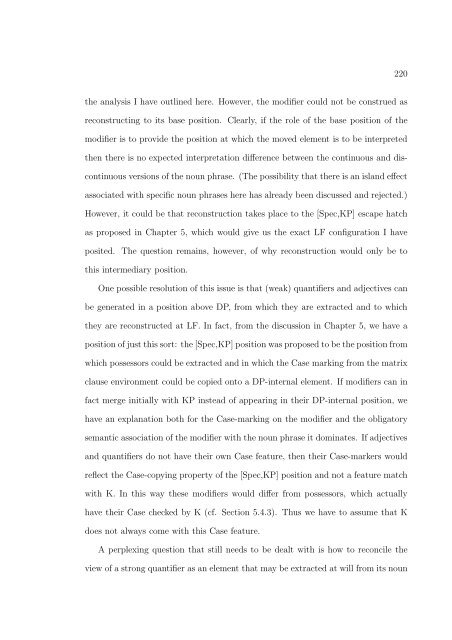the syntax and semantics of relativization and quantification
the syntax and semantics of relativization and quantification
the syntax and semantics of relativization and quantification
You also want an ePaper? Increase the reach of your titles
YUMPU automatically turns print PDFs into web optimized ePapers that Google loves.
220<br />
<strong>the</strong> analysis I have outlined here. However, <strong>the</strong> modifier could not be construed as<br />
reconstructing to its base position. Clearly, if <strong>the</strong> role <strong>of</strong> <strong>the</strong> base position <strong>of</strong> <strong>the</strong><br />
modifier is to provide <strong>the</strong> position at which <strong>the</strong> moved element is to be interpreted<br />
<strong>the</strong>n <strong>the</strong>re is no expected interpretation difference between <strong>the</strong> continuous <strong>and</strong> discontinuous<br />
versions <strong>of</strong> <strong>the</strong> noun phrase. (The possibility that <strong>the</strong>re is an isl<strong>and</strong> effect<br />
associated with specific noun phrases here has already been discussed <strong>and</strong> rejected.)<br />
However, it could be that reconstruction takes place to <strong>the</strong> [Spec,KP] escape hatch<br />
as proposed in Chapter 5, which would give us <strong>the</strong> exact LF configuration I have<br />
posited. The question remains, however, <strong>of</strong> why reconstruction would only be to<br />
this intermediary position.<br />
One possible resolution <strong>of</strong> this issue is that (weak) quantifiers <strong>and</strong> adjectives can<br />
be generated in a position above DP, from which <strong>the</strong>y are extracted <strong>and</strong> to which<br />
<strong>the</strong>y are reconstructed at LF. In fact, from <strong>the</strong> discussion in Chapter 5, we have a<br />
position <strong>of</strong> just this sort: <strong>the</strong> [Spec,KP] position was proposed to be <strong>the</strong> position from<br />
which possessors could be extracted <strong>and</strong> in which <strong>the</strong> Case marking from <strong>the</strong> matrix<br />
clause environment could be copied onto a DP-internal element. If modifiers can in<br />
fact merge initially with KP instead <strong>of</strong> appearing in <strong>the</strong>ir DP-internal position, we<br />
have an explanation both for <strong>the</strong> Case-marking on <strong>the</strong> modifier <strong>and</strong> <strong>the</strong> obligatory<br />
semantic association <strong>of</strong> <strong>the</strong> modifier with <strong>the</strong> noun phrase it dominates. If adjectives<br />
<strong>and</strong> quantifiers do not have <strong>the</strong>ir own Case feature, <strong>the</strong>n <strong>the</strong>ir Case-markers would<br />
reflect <strong>the</strong> Case-copying property <strong>of</strong> <strong>the</strong> [Spec,KP] position <strong>and</strong> not a feature match<br />
with K. In this way <strong>the</strong>se modifiers would differ from possessors, which actually<br />
have <strong>the</strong>ir Case checked by K (cf. Section 5.4.3). Thus we have to assume that K<br />
does not always come with this Case feature.<br />
A perplexing question that still needs to be dealt with is how to reconcile <strong>the</strong><br />
view <strong>of</strong> a strong quantifier as an element that may be extracted at will from its noun
















